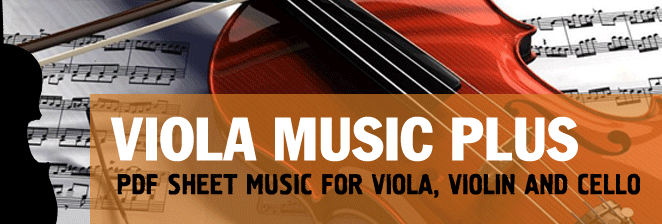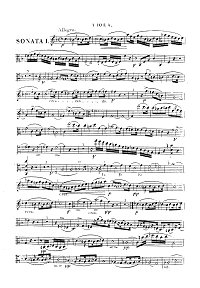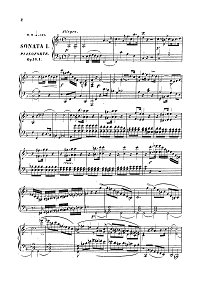|
|
 |
|
| |
| |
|
Onslow - Viola sonatas op.16 |
Onslow - Viola sonatas op.16
|
Onslow - Viola sonatas op.16. You can download the PDF sheet music Onslow - Viola sonatas op.16 on this page.
3 Cello Sonatas, Op.16 (Onslow, George)
Movements/Sections 3 sonatas
- Sonata in F major
- Sonata in C minor
- Sonata in A major
The Sonata for Viola and Piano first appeared in 1820 when it was published by Pleyel in Paris as part of "Three Sonatas for Piano and Cello". The composer dedicated the works to Charles Baudiot, Louis Norblin and A. Leonzzo de Leyval, whilst the publisher noted that "for want of a cello, a viola part has been arranged by the composer". Although clearly written for the cello, these works mark a particularly interesting stage in the instrument's repertoire as they are probably the first major pieces with piano available to a musician wanting to play viola, and also the work of a composer who, unusually, was not a violinist composing for his own performance. However, despite the skilfulness of the transcription, one could express some reservations about the viola version; and in comparison there is little doubt that the original instrumentation is superior.
To download PDF, click the "Download PDF" button below the appropriate sheet music image.
To view the first page of Onslow - Viola sonatas op.16 click the music sheet image.
|
| PDF format sheet music |
|
|
|
Instrument part: 18 pages. 2872 K
|
Piano part: 63 pages. 8797 K
|
 |
 |
| +++ |
+++ |
| Download PDF (14.99
€) |
Download PDF (14.99
€) |
|
Thus, much of the interplay involving the contrast and complementarity of the cello and piano tessituras is often lost as most of the score has been raised an octave. On several occasions, the mysterious bass of the cello is essentially lacking, as in the opening of the fourth movement of the Sonata opus 16, no. 2 in C minor wherein the broad four octave range is reduced to three for the viola.
Some passages conceived so that lower register of the cello plays its bass role (a tessitura lower than the left hand of the piano) cannot be played on the viola, which leads to a less convincing harmonic result. Also, the composer is sometimes required to make abrupt changes in register which inevitably interrupt the original melody line (Sonata op. 16, no. 1 in F major, first movement allegro).
In order to compensate for the differences in range between the viola and cell, and to remain within reasonable technical limits, on several occasions Onslow preferred to change certain elements of the score. Thus, for an arpeggio where the literal transposition to the octave would have been perilous, he chose not to go beyond the cello's range and instead rewrite the section (Sonata opus 16, no. 1, first movement).
In his adaptation, Onslow seems concerned with retaining, as much as possible, the musical coherence of the sonatas. Thus, in order to respcct the rapport of tessituras he inverts the pizzicati movement in the Trio of the Minuetto in the Sonata opus 16, no. 2, sacrificing an appealing contrast with the piano. He also removes a fragment of the score (Sonata opus 16, no. 1, first movement, bar 50) in order to preserve a certain stylistic logic and avoid a awkward octave leap. Finally, Onslow does not hesitate to change the line of some transitions in order to better prepare for a change in tessitura (Sonata opus 16, no. 2, second movement, Adagio cantabile).
It is difficult to be certain of the motivations that lead Onslow to publish the two versions simultaneously, perhaps it was the desire to enhance the repertoire of an increasingly-popular instrument, the commercial interest of a publisher looking to enlarge his clientele or the request of a musician. Nevertheless, in parallel with the composer's predilection for the cello, it is interesting to note that on innumerable occasions he would display a real interest for the viola in his works. In his quartets and quintets the instrument shares in the overall virtuosity and plays an extremely active role in the discourse. The viola is sometimes features as soloist (Trio of the Menuetto in the Quartet op 47), and becomes predominant in the Quartet op. 52 where it states the entire theme and dialogues as an equal partner with the first violin - without shying away from a superb technical demonstration. The inspired writing featured in the two quintets, op. 78 and 80 (for two violins, viola and bass), is proof of the composer's understanding of the expressive potential of the viola.
In all his sonatas, for the upper range of the viola, Onslow never goes higher than the B above the staves (alto clef).
In this movement Onslow writes for the viola in sixth position, a high C above the staves (alto clef), a rarity within the quartet repertoire. With Beethoven, the viola never goes beyong the thirscl position; Schumann was one of the rare to call for the fifth position with a B flat above the staves in the finale of his Quartet op. 41, no. 1.
|
|
|
|
28 August 2017 |
|
Last Updated on 28 August 2017 |
|
|
| |
|
|
| |
|
|
|
|